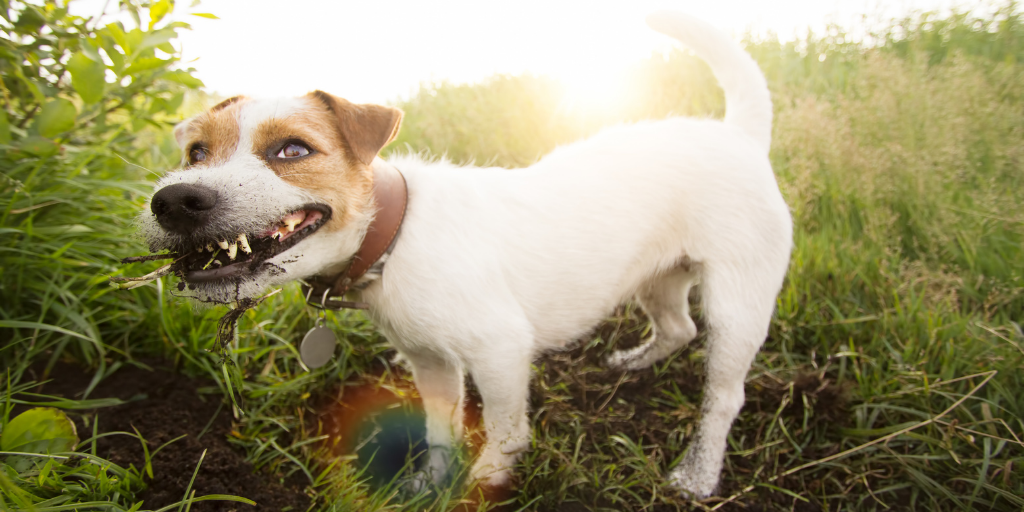Our older dog Brody loves dirt and mud. Not rolling in it...eating it. But this wasn't always the case. The behavior developed over the last few years after we moved to an area where mud and dirt was readily available. Dirt eating is a form of "pica" (the ingestion of nonfood items and materials) known as "geophagia" or "geophagy." It's not that uncommon in dogs and is generally nothing to worry about (assuming the dirt is free of pesticides, chemicals or microorganisms and your dog isn't eating large amounts frequently or compulsively). Still, it's a good idea to discourage and prevent the behavior, as we try to do with our dog. So, why do dogs eat dirt and mud? And how do you prevent it?
Why Do Dogs Eat Dirt?
1. It Tastes And Smells Good
The most common reason dogs eat dirt is that it's appealing to them. Dogs are scavengers and foragers - they enjoy getting into things, especially pungent things. This is also why you may notice your dog getting into garbage or cat litter. Some dogs may just enjoy the smell, texture or taste of dirt.
2. Curiosity
Dogs don't have hands, so the only way they can hold something is with their mouth. Because of this, dogs (especially puppies) use their mouths as a way to explore the world around them. This is often referred to as "mouth-testing." A dog who eats dirts may just be curious about the substance, trying to figure out if it's food. Over time, puppies and dogs will learn what they can and can't consume.
Pro Tip: It's important to train your dog not to put objects in their mouths, so they develop good habits. When you see your puppy grabbing something they shouldn't with their mouth, quickly and gently instruct them not to.
3. Boredom
Another reason dogs eat dirt is out of boredom. Dogs become bored because they don't have enough to do or think about and are not able to expend their excess energy. In particular, boredom often occurs when a dog isn't getting enough physical exercise, mental stimulation, socialization, enrichment, playtime or entertainment. Bored dogs may engage in destructive and attention seeking behaviors, which could manifest as dirt digging and eating.
4. Anxiety Or Stress
Anxious or stressed dogs may turn to dirt eating to calm their nerves. Sniffing, digging and putting things in the mouth or eating them (edible and inedible things alike) can all be soothing activities and behaviors. For instance, a dog may dig to bury their food or treats if they're anxious that the area they were fed in isn't safe. They will then eat their goodies later at a time or place that feels safer and more comfortable. Another example is a dog suffering from separation anxiety who may tear apart or try to eat bedding, curtains, carpet, paper, etc. to cope with the panic he or she is feeling. Dirt eating may just be your dog's way of easing their anxiety.
5. Nutritional Deficiency
One reason dogs may eat dirt is because of a nutritional imbalance or mineral deficiency. Dirt is full of minerals and eating it may be their way of trying to correct a deficiency. Although rare, nutritional imbalances occur when your dog isn't absorbing enough essential minerals and nutrients. They can be caused by low-quality food, hormonal conditions, gastrointestinal issues and homemade diets. It's best to talk to your vet for help choosing a sufficient and effective dog food.
Pro Tip: Making your dog's food at home, rather than using commercial pet food, is a totally fine way to feed your dog - as long as it's still a balanced diet. To ensure your dog is getting the nutrients they need, talk to your vet. You may need to add multivitamins or other supplements.
6. Anemia
Anemia, though rare, occurs when your dog has low blood cell count, hemoglobin levels or both. It can be caused by a nutritional imbalance among other things. The theory is that anemic dogs may eat dirt to restore the deficiencies causing the issue, specifically iron. The only reliable way to diagnose anemia in a dog is through bloodwork and testing by a vet. Symptoms of anemia in dogs include change in the gum color from normal pink to pale pink or white (the most easily and commonly observed sign), lethargy or low energy, easily tired or low stamina, listlessness, loss of appetite, weight loss, labored breathing, increased heart rate, bloody nose and blood in stool, urine, or vomit.
7. Upset Stomach And Other Medical issues
Sometimes, dirt eating may indicate other medical conditions, particularly of the stomach and liver. These can include gastrointestinal and digestive issues such as irritable bowel syndrome, parasites and SIBO (small intestinal bacterial overgrowth). In addition, those with liver, kidney or gallbladder issues may turn to dirt eating. However, dogs usually turn to grass rather than dirt to soothe their bowels. Pica can also be a neurological issue or caused by an illness, so consult your vet if your dog suddenly starts eating non-food items frequently, compulsively and in large amounts.
Pro Tip: It's a good idea to go to the vet if your dog is not acting like themselves, isn't feeling well, seems lethargic and off, has changes in stool etc. on top of eating dirt.
When To See A Vet
If you notice your dog eating dirt, monitor them to make sure they didn't ingest anything or cause internal injuries. If they begin acting differently or off, contact your vet. Also keep an eye out to monitor whether it's a frequent occurrence or compulsive behavior. If it becomes a habit, you may want your vet to check for underlying health conditions.
The Risks Of Eating Dirt
Though it's usually not harmful, there are some risks to letting your dog eat dirt. These include:
- Impacted intestines, particularly if a lot is eaten at once (which could wind up requiring surgery to resolve)
- Consumption of pesticides, fertilizers, chemicals and other toxins
- Ingestion of parasites
- Choking
- Damage to the teeth, throat, intestine or stomach from rocks or sticks
- Obstruction of the throat, intestine or stomach from rocks or sticks
How To Prevent Dirt Eating
The methods for preventing your dog from eating dirt will vary based on the frequency and cause of the behavior.
- Interrupt the behavior (even better - try to catch your dog before they eat dirt).
- Distract your dog with a verbal command, noise or something acceptable to chew.
- Begin doing a completely different activity (such as fetch, running or training exercises).
- Provide your dog with enough daily physical exercise and mental stimulation to reduce boredom, attention seeking behaviors or stress and anxiety.
- Give plenty of acceptable and safe things to chew, such as toys or bully sticks, to satisfy your dog's urge to put things in their mouth.
- Leash your dog when outside so you can lead them away from any dirt on walks or keep them from reaching dirt in the yard.
- Deny access to dirt (if possible) in your yard or garden and removing indoor plants or placing them out of reach.
- Talk to your vet about deworming, in case the dirt eating is caused by parasites.
- Change, upgrade or supplement your dog's diet to correct any nutritional deficiencies or imbalances. (It's always a good idea to consult your vet before switching up food or adding supplements).
- Address any potential causes of stress and anxiety.
- Seek help from a professional trainer or dog behaviorist.
How To Train Your Dog Not To Eat Dirt
To train your dog not to eat dirt (or to stop eating dirt), you'll want to redirect your dog's attention from the non-food item. Using a leash is one of the easiest ways to do this:
- After leashing your dog, practice looking at you while walking.
- If your dog reaches for some dirt, get their attention with a cue to distract them (for example, "look" or "leave it").
- Reward your dog every time they look at you or leave it on command.
- Make sure to reward your dog every time they leave dirt alone, cue or no cue.
- Use a high value reward, one that is more enticing to your dog than dirt.
- Don't yell at, pull away or punish your dog as that can just exacerbate the situation by triggering or worsening fear, anxiety or stress.

